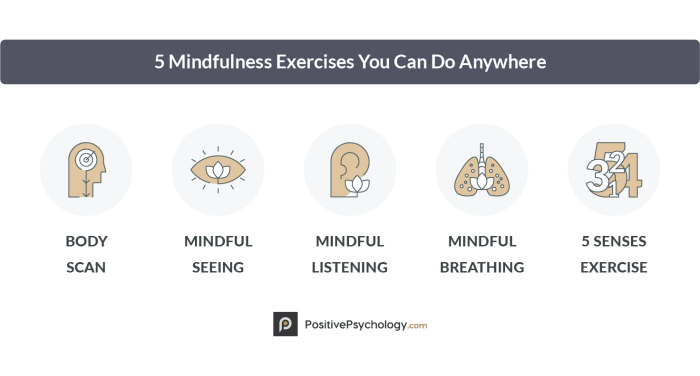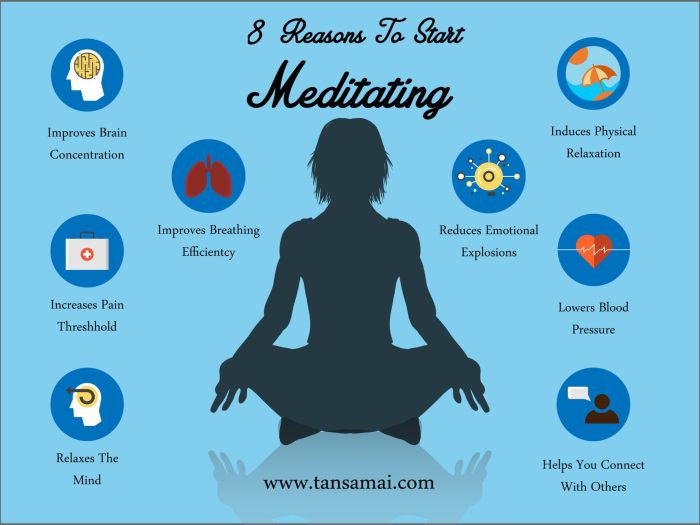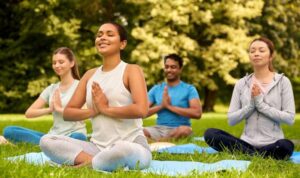Mindfulness Exercises are all the rage these days, helping you boost your mental and physical health while increasing productivity. Dive into this trendy practice with our guide!
Whether you’re a beginner or a seasoned pro, there’s something for everyone in the world of mindfulness exercises. Let’s explore the benefits, types, and ways to incorporate mindfulness into your daily routine.
Benefits of Mindfulness Exercises

Mindfulness exercises offer a wide range of benefits for both mental and physical health, as well as enhancing productivity and focus.
Improving Mental Health
- Reduces stress and anxiety levels through increased awareness of thoughts and emotions.
- Enhances emotional regulation and resilience, leading to better coping mechanisms.
- Improves overall sense of well-being and happiness by fostering a positive outlook on life.
Physical Health Benefits
- Decreases blood pressure and heart rate, promoting cardiovascular health.
- Boosts immune system function by reducing inflammation in the body.
- Improves sleep quality and aids in better digestion through relaxation techniques.
Enhancing Productivity and Focus
- Increases cognitive flexibility and creativity by training the brain to focus on the present moment.
- Enhances decision-making skills by reducing impulsivity and promoting thoughtful responses.
- Improves concentration and memory retention, leading to better performance in tasks and activities.
Types of Mindfulness Exercises
Mindfulness exercises come in various forms, each offering unique benefits to help individuals cultivate a sense of presence and awareness in their daily lives.
Breathing Exercises
Breathing exercises are a fundamental aspect of mindfulness practice, focusing on the breath to anchor attention to the present moment. Benefits include reducing stress, improving focus, and promoting relaxation. Here’s a simple step-by-step guide for beginners:
- Find a comfortable seated position.
- Close your eyes and take a few deep breaths to center yourself.
- Focus on the sensation of your breath entering and leaving your body.
- Notice the rise and fall of your chest or the feeling of air passing through your nostrils.
- If your mind wanders, gently bring your attention back to your breath without judgment.
- Continue for a few minutes, gradually increasing the duration as you become more comfortable.
Body Scan
Body scan exercises involve systematically bringing awareness to different parts of the body, noticing sensations without attachment or aversion. This practice can help release tension, improve body awareness, and promote relaxation. Here’s how to do a body scan:
- Lie down in a comfortable position, close your eyes, and take a few deep breaths.
- Start by focusing on your toes, noticing any sensations or tension present.
- Slowly move your attention up through each body part, releasing tension as you go.
- Pay attention to any areas of discomfort or relaxation without trying to change them.
- Finish by bringing your awareness to your body as a whole, feeling grounded and present.
Mindful Walking
Mindful walking combines the practice of walking with mindfulness, focusing on each step and the sensations of movement. Benefits include grounding oneself, increasing awareness of the body, and promoting a sense of calm. Here’s a beginner’s guide to mindful walking:
- Find a quiet space to walk, either indoors or outdoors.
- Start by standing still and bringing your attention to the soles of your feet.
- Begin walking slowly, paying attention to the sensations of each step.
- Notice the shifting of your weight, the movement of your muscles, and the contact with the ground.
- If your mind wanders, gently guide your focus back to the present moment through your footsteps.
- Continue walking mindfully for a few minutes, enjoying the experience of being fully present in each step.
Incorporating Mindfulness into Daily Routine

To make mindfulness a part of your daily routine, start by setting aside specific time each day for practice. This can be in the morning, during lunch break, or before bedtime. Consistency is key in forming a habit.
Best Times of Day for Mindfulness
- Early Morning: Starting your day with mindfulness can set a positive tone for the rest of the day. It can help you focus and stay grounded amidst any challenges that may come your way.
- Lunch Break: Taking a few minutes during your lunch break to practice mindfulness can help you recharge and refocus for the rest of the day.
- Before Bed: Practicing mindfulness before bed can help you unwind, relax, and prepare your mind and body for a restful night’s sleep.
Integrating Mindfulness into Everyday Activities
- While Eating: Practice mindful eating by savoring each bite, being present with the taste and texture of your food, and paying attention to feelings of hunger and fullness. This can help you develop a healthier relationship with food.
- During Commuting: Use your commute time to practice mindfulness by focusing on your breath, observing the sights and sounds around you without judgment, and being fully present in the moment. This can help reduce stress and increase your overall sense of well-being.
Mindfulness Apps and Resources: Mindfulness Exercises
When it comes to practicing mindfulness, there are a variety of apps and resources available to help guide you through meditation and exercises. These tools can be valuable in developing a consistent mindfulness practice and improving overall well-being.
Popular Mindfulness Apps
- Headspace: Offers guided meditation sessions and mindfulness exercises for beginners and experienced practitioners alike.
- Calm: Provides a wide range of meditation programs, sleep stories, and relaxation techniques to reduce stress and anxiety.
- Insight Timer: Features a large library of free guided meditations, music tracks, and talks from mindfulness experts.
Comparing Mindfulness Resources
Aside from apps, there are other mindfulness resources such as books, podcasts, and online courses that can support your mindfulness journey.
- Books: “The Power of Now” by Eckhart Tolle and “Wherever You Go, There You Are” by Jon Kabat-Zinn are popular choices for exploring mindfulness.
- Podcasts: “The Mindful Minute” and “The Daily Meditation Podcast” offer daily mindfulness practices and discussions on various mindfulness topics.
- Online Courses: Platforms like Coursera and Udemy provide courses on mindfulness and meditation led by experts in the field.
Personal Experiences with Mindfulness Apps, Mindfulness Exercises
“Using the Headspace app has helped me establish a daily meditation routine and manage my stress levels more effectively. The guided sessions make it easy to focus and stay present in the moment.”
“I’ve found Insight Timer to be a valuable resource for exploring different meditation techniques and connecting with a community of like-minded individuals. The variety of content keeps me motivated to continue my mindfulness practice.”

